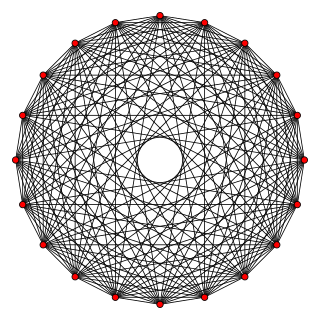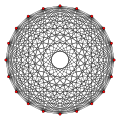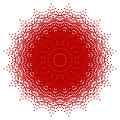Top Qs
Timeline
Chat
Perspective
Rectified 10-orthoplexes
From Wikipedia, the free encyclopedia
Remove ads
In ten-dimensional geometry, a rectified 10-orthoplex is a convex uniform 10-polytope, being a rectification of the regular 10-orthoplex.
There are 10 rectifications of the 10-orthoplex. Vertices of the rectified 10-orthoplex are located at the edge-centers of the 9-orthoplex. Vertices of the birectified 10-orthoplex are located in the triangular face centers of the 10-orthoplex. Vertices of the trirectified 10-orthoplex are located in the tetrahedral cell centers of the 10-orthoplex.
These polytopes are part of a family of 1023 uniform 10-polytopes with BC10 symmetry.
Remove ads
Rectified 10-orthoplex
Summarize
Perspective
| Rectified 10-orthoplex | |
|---|---|
| Type | uniform 10-polytope |
| Schläfli symbol | t1{38,4} |
| Coxeter-Dynkin diagrams | |
| 9-faces | |
| 8-faces | |
| 7-faces | |
| 6-faces | |
| 5-faces | |
| 4-faces | |
| Cells | |
| Faces | |
| Edges | 2880 |
| Vertices | 180 |
| Vertex figure | 8-orthoplex prism |
| Petrie polygon | icosagon |
| Coxeter groups | C10, [4,38] D10, [37,1,1] |
| Properties | convex |
In ten-dimensional geometry, a rectified 10-orthoplex is a 10-polytope, being a rectification of the regular 10-orthoplex.
The rectified 10-orthoplex is the vertex figure of the demidekeractic honeycomb.
















 or
or 


















Alternate names
- Rectified decacross (Acronym: rake) (Jonathan Bowers)[1]
Construction
There are two Coxeter groups associated with the rectified 10-orthoplex, one with the C10 or [4,38] Coxeter group, and a lower symmetry with two copies of 9-orthoplex facets, alternating, with the D10 or [37,1,1] Coxeter group.
Cartesian coordinates
Cartesian coordinates for the vertices of a rectified 10-orthoplex, centered at the origin, edge length are all permutations of:
- (±1,±1,0,0,0,0,0,0,0,0)
Root vectors
Its 180 vertices represent the root vectors of the simple Lie group D10. The vertices can be seen in 3 hyperplanes, with the 45 vertices rectified 9-simplices facets on opposite sides, and 90 vertices of an expanded 9-simplex passing through the center. When combined with the 20 vertices of the 9-orthoplex, these vertices represent the 200 root vectors of the simple Lie group B10.
Images
Remove ads
Birectified 10-orthoplex
Alternate names
- Birectified decacross (Acronym: brake) (Jonathan Bowers)[2]
Cartesian coordinates
Cartesian coordinates for the vertices of a birectified 10-orthoplex, centered at the origin, edge length are all permutations of:
- (±1,±1,±1,0,0,0,0,0,0,0)
Images
Remove ads
Trirectified 10-orthoplex
Alternate names
- Trirectified decacross (Acronym: trake) (Jonathan Bowers)[3]
Cartesian coordinates
Cartesian coordinates for the vertices of a trirectified 10-orthoplex, centered at the origin, edge length are all permutations of:
- (±1,±1,±1,±1,0,0,0,0,0,0)
Images
Quadrirectified 10-orthoplex
Alternate names
- Quadrirectified decacross (Acronym: terake) (Jonthan Bowers)[4]
Cartesian coordinates
Cartesian coordinates for the vertices of a quadrirectified 10-orthoplex, centered at the origin, edge length are all permutations of:
- (±1,±1,±1,±1,±1,0,0,0,0,0)
Images
Remove ads
Notes
References
External links
Wikiwand - on
Seamless Wikipedia browsing. On steroids.
Remove ads






































